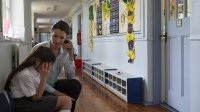Why Restorative Practices Benefit All Students
Punitive discipline can be harmful and unfair—restorative practices offer hopeful solutions.
Did you know that a significant percentage of the achievement gap between students of color and white students is caused by punitive discipline? African American and Latino children are much more likely to face school suspension and expulsion—even for the same behaviors—than white students.
As a response to this inequitable school model of punitive discipline measures, restorative practices are growing in schools across the nation.
I asked Brian H. Smith, Ph.D., a research scientist with the Committee for Children, to share his perspectives on the current status and future directions of discipline in schools.
EDUTOPIA: What is the current status of the discipline system and such practices as zero tolerance?
DR. BRIAN SMITH: Suspension and expulsion disrupt students’ learning and erode their connection to school. More than that, however, recent research conducted by sociologists Brea Perry and Edward Morris shows that exclusionary discipline also harms the “academic achievement of non-suspended students” (American Sociological Review, December 2014, vol. 79, no. 6, 1067-1087).
Suspension rates increased dramatically in the 1990s as schools embraced zero-tolerance discipline policies. But these are approaches that criminalize misbehavior without reducing it. This kind of punitive discipline is a failed strategy that harms the education of millions of students, especially the most disadvantaged.
EDUTOPIA: Why do you think these practices persist?
DR. BRIAN SMITH: Part of the value of research is it helps us question and test things that seem obvious but might not be true. Removing students when they are struggling to behave can appear successful because students don’t cause difficulties in school if they’re not there. But this new research clearly shows the longer-term negative effects of this punitive approach, particularly on students of color who particularly need strong connections to school and who often face multiple challenges to school success.
EDUTOPIA: There has been a growing emphasis recently on preventive and restorative approaches. What are they and how do they work best?
DR. BRIAN SMITH: We’ve only recently begun to understand how childhood stress and adversity powerfully affect development and impair students’ ability to behave and learn in school. We also increasingly understand the importance for all children, especially those who struggle, of having supportive school environments where they feel accepted. Research shows it is effective to provide clear expectations for behavior, teach skills needed to succeed in the school environment, and respond to problems with strategies to strengthen connections and relationships, rather than push students away.
Schools seeking to create a positive school community and respond in an effective way when problems do arise are increasingly turning to restorative practices. According to the International Institute for Restorative Practices, “The aim of restorative practices is to develop community and to manage conflict and tensions by repairing harm and building relationships.”
Restorative practices strengthen students’ connections to both staff and other students, and that’s why restorative practices support both prevention and response. Focusing on positive connections and support contributes to a positive school climate. Repairing harm and restoring relationships after transgressions helps keep students connected to a positive school community.
EDUTOPIA: How do these practices relate to social-emotional and character development?
DR. BRIAN SMITH: These approaches fulfill two key character education principles: providing students with opportunities for moral action and creating a caring school community.
Clear expectations, fair consequences, and restorative conversations and agreements only work when students have self-regulation, emotion knowledge, and social skills—competencies taught through social-emotional learning (SEL). Social-emotional competence prepares and supports all children for the intellectual and interpersonal challenges of the formal school environment.
Restorative practices that build positive school climate and healthy relationships depend on the foundation provided by SEL: students’ abilities to take other’s perspectives, be aware of their own thoughts and feelings, communicate effectively, and solve problems.
